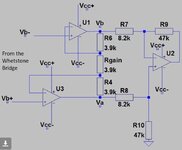khaled maher
Newbie
Good Day
For my RTD, I will use a Whetstone Bridge connected to Instrumentation amplifier as shown below.
The sensor will be installed in a small factory beside a number of three phase motors so I decided to add an active low pass filter.
But I have a number of questions:
1. How much the cuttoff frequency "Fc" suppose to be. i.e. does the noise range for such a workplace could be known ??
2. Should I apply the filter after the Whetstone Bridge or after the instrumentation amplifier or it doesn't matter ??
3. Does the CMRR of my Op-Amps would works as a filter or it is better add an active filter ??
Thank You
For my RTD, I will use a Whetstone Bridge connected to Instrumentation amplifier as shown below.
The sensor will be installed in a small factory beside a number of three phase motors so I decided to add an active low pass filter.
But I have a number of questions:
1. How much the cuttoff frequency "Fc" suppose to be. i.e. does the noise range for such a workplace could be known ??
2. Should I apply the filter after the Whetstone Bridge or after the instrumentation amplifier or it doesn't matter ??
3. Does the CMRR of my Op-Amps would works as a filter or it is better add an active filter ??
Thank You
